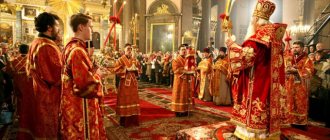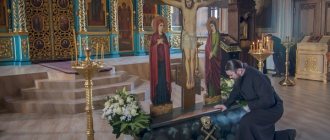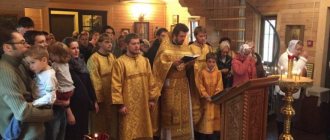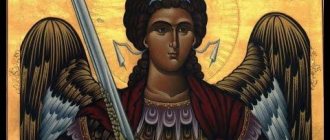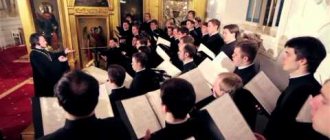Part 2
After these prayers, the actual festive, main and most important part of Matins begins, called the canon.
Prof. M. Skaballanovich points out that the trisong can be considered the original form of the canons. In early worship, in addition to psalms, biblical songs were also used, and troparia with Christian content began to be composed for them as choruses. “Choruses in the form of troparions to biblical songs are indicated by the already well-known description of the Sinai Matins of the 6th-7th centuries. (Introduction, ch. 328); It is remarkable that in this description the choruses to the 8th song stand out from the others, although they have the same name “troparia”; it is possible that the choruses to the remaining songs took the form of short and monotonous verses for each song (for the 1st “We will sing to the Lord, gloriously be glorified”, for the 2nd “Glory to you God”, for the 3rd “Holy art thou, Lord and thee my spirit sings,” etc.), and only for the 8th canto there were “troparia,” and if this is so, then the original form of the canon was the same canticle. The one-song gradually increased to the two-song, through the addition to the 8th and 9th songs”20. Later, three songs appeared, then full canons.
The canon consists of 9 hymns, and the 2nd hymn does not occur at all-night vigils (it, as a penitential hymn, is only present in the services of the weekdays of Great Lent) and immediately after the 1st hymn follows the 3rd hymn. Each hymn at the all-night vigil begins with the singing of the so-called “Irmos”, then follows the reading of troparions with refrains for each of them, and the hymn concludes with the singing of the so-called “Katavasia”. The basis of the canon are the so-called “Songs of the Holy Scriptures”. These are hymns to the Lord God, found mainly in the Old Testament, in the Bible (only the 9th hymn, consisting of two parts, is borrowed from the New Testament).
The first song was sung by Mariamne, the sister of Moses, on the occasion of the miraculous passage of the Jews across the Red (Red) Sea. It begins with the words: “We sing to the Lord, gloriously we will be glorified” (Ex. 15: 1-19).
2nd song of Moses during the Jews’ wanderings in the desert: “Look into the heavens and I will say” (Deut. 32: 1–44).
3rd song of Anna, mother of the prophet Samuel, in gratitude for the birth of her son: “My heart be established in the Lord” (1 Samuel 2:1-10).
4th song of the Prophet Habakkuk, who saw God coming from the shadowed mountain: “Lord, I heard your hearing and was afraid” (Hab. 3:2-20).
5th song of the Prophet Isaiah, who announced the birth of Emmanuel from the Virgin: “From the night my spirit rises to thee, O God” (Is. 26:9-20).
6th song of the Prophet Jonah, who was in the belly of the whale for three days and three nights and then thrown onto dry land by the whale: “I cried out in my sorrow to the Lord God” (Jon. 2:1-7).
7th song of the three youths in the fiery furnace: “Blessed art thou, O Lord, God of our fathers” (Dan. 3:26-56).
The 8th song of the same youths: “Bless all the works of the Lord the Lord, sing praises and exalt him forever” (Dan. 3, 57-72).
The 9th hymn consists of two parts: from the song of the Most Holy Theotokos during Her visit to Elizabeth: “My soul magnifies the Lord” (Luke 1:46–55); and songs of St. Prophet Zechariah, father of St. John the Baptist: “Blessed is the Lord God of Israel, for He has visited and brought deliverance to His people” (Luke 1:68–79).
All these songs in their entirety, as they are set out in the Bible, are prescribed by the charter to be sung or read only on the weekdays of St. Pentecost. First, the song itself is versified, then from the verse that has o, or “on 8”, “on 6”, “on 4”. For example, let’s take the 1st hymn: “We sing to the Lord”: we sing verse by verse up to “Augustesh”, on 14 (inclusive), after the verse “Augustesh”: immediately follows – Irmos of the canon and then, in turn, all the troparia of the canon, so that the verses serve as songs refrains to the troparions of the canon.
On holiday days, the songs themselves are not supposed to be versified, but the choruses of the songs to the troparions of the canon are usually replaced by other choruses that have a connection with the content of the canon. So, for example, now the troparions of the Sunday canon have the refrain: “Glory, Lord, to Your holy resurrection
", for the troparions of the canons on the Lord's feasts:
"Glory to Thee, our God, glory to Thee
", for the cross-resurrection canon:
"Glory to the Lord, Thy Cross and Resurrection
", for the troparions of the canons for the Mother of God feasts:
"Most Holy Theotokos, save us."
During the Lenten Triodion, on Vel.
canon: “God have mercy on me, have mercy on me
.”
At the Sunday Midnight Office: “Most Holy Trinity, our God, glory to Thee
.”
The feasts of saints also have their own choruses, which represent a prayerful appeal to these saints, for example: “Holy archangels and angels, pray to God for us
,”
“St.
Great John, Forerunner of the Lord, pray to God for us ”,
“St. Father Nicholas, pray to God for us
”, or:
“St.
Great Martyr, or
St.
martyr , or
named venerable
martyr, pray to God for us.”
To the venerables: “Reverend Father Andrew,
or
Seraphim, pray to God for us
,” “
Reverend Mother Mary, pray to God for us
.”
The very word “canon” κανων translated from Greek means “rule,” prescription, measure, and in this case means the combination of a series of chants according to a well-known rule. The Typikon distinguishes two types of such a connection, or canon system: the everyday system is designated conventionally by the words “We sing to the Lord.”
”, festive - with the words
“We sing to the Lord
”. Under the holiday system, the above-mentioned songs of the Holy Scriptures are not versified, and the canon consists only of irmos, troparions of songs, with choruses to them, and Katavasia.
Irmos is the chant with which each song of the canon begins. The irmos borrows its content and even some individual words and characteristic expressions from the corresponding song of the Holy Scriptures. The very word “irmos” - ειρμος - means “connection” and shows that irmos serves as a connection between the songs of Holy Scripture and the troparia of the canon.
Following the irmos, the troparia of the canon are read with choruses to them and, finally, on holidays, each hymn ends again with the irmos, which is called katavasia, which means “convergence”, because in order to sing the irmos, the charter requires the singers of both choirs (choirs) to come together to the middle of the temple .
The author of the Sunday canons is undoubtedly the Venerable John of Damascus (675–750).
At a Sunday vigil, the canon is usually a combination of four canons into one, which consists of the Sunday canon, the canon of the cross, the canon of the Theotokos (all three are printed in a row in the Octoechos) and the canon for the saint of a given day from the Menaion. At the vigils of the twelve feasts and great saints there are usually two canons, sometimes only one canon for a given feast or saint. On holidays, the canon is usually sung, technically speaking, on the 16th (on Easter, on the Nativity of Christ) or on the 14th, as indicated in the charter. This expression “for 16” or “for 14” does not mean that the canon necessarily contains this number of troparia with irmos, but that the troparia must be sung or read so many times that there are 16 or 14 in each song. According to the charter, the irmos and troparia of the canon must be sung by two choirs, that is, by two choirs in turn, and sometimes the irmos are ordered to be sung twice (four times on Easter). In Rus', from the middle of the 17th century, they gradually switched from singing the troparions of the canon to reading, so as not to lengthen the service too much. Currently, it is customary to sing the troparia of the Easter Canon.
Each hymn of the canon at the vigil, as well as at the festive matins in general, concludes with chaos. Disasters happen at different times of the year. More often than others, the chaos of “all summer” is sung - “over my mouth.” (These are the irmos used on the feasts of the Mother of God, although on the days of the twelfth feasts of the Mother of God, some of them are adapted to the festive event and changed). This chaos is sung during all those periods of the year when there is neither a pre-celebration nor a post-celebration of any Twelfth Feast. In addition to it, there are also confusions that are sung over a significant period of time. These are: “The day of Resurrection...”, which is sung from Easter until the day of Easter, except for Midnight with its day and the 6th week after Easter; “Moses drew the Cross” from August 1 to the celebration of the Exaltation on September 21, excluding some days associated with the Feast of the Transfiguration and the Feast of the Assumption; “Christ is born, glorify” from November 21, the feast of the Entry into the Temple of the Most Holy Theotokos, until the celebration of the Nativity of Christ on December 31. There are also katavasiyas that are sung for a shorter period of time, which is always indicated in the liturgical books in a row. Accurate and complete data about when which chaos is sung are placed in the 19th chapter of the Typikon.
When singing the canon, after the 3rd, 6th and 9th songs, a small litany is pronounced, which serves to arouse the attention of those praying, while praising the Lord and His saints, in order to pray for themselves. In these litanies we ask the Lord to intercede, save, have mercy and preserve us with His grace and, remembering all the saints and the Mother of God, we commend ourselves and our whole life to Christ our God. The priest, after each of these litanies, proclaims why we surrender ourselves to God. According to the 3rd song: “For you are our God”; according to the 6th: “For you are the king of the world and you have saved our souls”; according to the 9th: “For all the powers of heaven praise you.” And with each of these exclamations he sends glory to the Father, and the Son, and the Holy Spirit, now and ever, and unto ages of ages.
Each of the three parts of the canon, thus concluded by a small litany, is accompanied by one short chant, sometimes consisting of several parts, which immediately follows the small litany.
After the 3rd song of the canon, sedalnas or ipakoi are sung or read. According to the 6th canto there is always kontakion and ikos. According to the 9th canto, exapostilary or luminary. Sometimes kontakion and ikos occur after the 3rd canto, especially when two celebrations are combined on one day. Then the kontakion of a more significant festival is sung after the 6th canto, and the kontakion of a less significant festival is moved to the place after the 3rd canto, before the sedal. After the 6th canto, there is always only one Kontakion and Ikos, while after the 3rd canto it is possible to connect several sedals; Likewise, according to the 9th song, there is a connection of several lamps.
According to the 3rd canto and the sedalna, according to the charter, there is a “reading” relating to this holiday. According to the 6th song, after the kontakion and ikos, the so-called “Synaxarion” is placed (from the Greek - συναγω - “I gather”, “I collect”), which contains a set of information about this festive event or about the person of the celebrated saint. Information about the holidays, as well as about the lives of the saints, can be found, as indicated in the Synaxarion, in the Lives of the Saints or in the Prologue, or in special collections. Also in the works of St. Teachers and Preachers have “Words” dedicated to the memory of saints or festive events.
It is always necessary to inquire about how several canons are united together when several celebrations coincide, during an all-night vigil, in the so-called “Mark chapters” printed in the Menaion and Triodion, and also, of course, in the Typikon. It is important to know that on Sundays the canon must always be sung at 14. The Irmos of the Sunday canon are sung once, and the troparia at 14 and then katavasia.
At ordinary Sunday Matins, the Sunday canon is sung at 4, including the Irmos, which is sung once; the Resurrection of the Cross is sung at 3, the Theotokos at 3, and the saint from the Menaion at 4; the last three canons without irmos.
The Sunday canon is not sung only on the twelve feasts of the Lord, but on the Mother of God it is invariably sung, and also on December 24th it is not sung if it falls on a Sunday, for there is a special Sunday canon laid down in the Menaion.
The Canon of the Cross is not sung in those weeks in which a saint's feast with a vigil, a temple feast, a forefeast or an afterfeast occurs. In general, it is sung only when the canons of the Menaion or Triodion of a saint or holiday are sung on 6; if they are sung at 8, then the Cross-Sunday canon is omitted.
The Canon of the Theotokos (always placed in third place in the Sunday service of the Octoechos) is not sung in those weeks in which a forefeast or afterfeast occurs, and, moreover, a saint with a vigil or a temple, or two saints who are entitled to two canons, and, in general, when it is sung , in addition to the Sunday canon, there are two canons, one of which is 4, and the other is 6 (that is, 10 in total).
During the weeks of singing the colored triodion from Easter to the Sunday of All Saints, the Sunday, Cross and Theotokos canons of the Octoechos are not sung at all, and only the canons of the triodion are sung. If during these weeks there is a temple holiday or a saint with polyeleos, then the canons of the Triodion and Menaion are sung.
At the end of the 8th song of the canon, before the chaos, it is sung: “We praise, bless, worship the Lord, singing and exalting Him to all ages.” Then the 9th song of the Holy Scripture is sung: “My soul magnifies the Lord” with the refrain: “The most honorable cherub.” The song “Most Honest” is the irmos of the 9th song of the triple canticle of Good Friday, “To you in the morning,” and the compiler of this triple canticle is Rev. Cosmas Mayumsky (700–760). He used the words of Rev. for this song. Ephraim the Syrian about the Mother of God: “The most honorable cherub and without comparison of all the heavenly armies”21. When singing this song, censing is required. The deacon or priest, if there is no deacon, already during the 8th canon of the canon censes the entire altar, then, while singing the katavasiya of the 8th canto, leaves the altar through the northern doors, censes the iconostasis and, stopping in front of the icon of the Mother of God, as soon as they finish singing chaos, proclaims: “Let us exalt the Virgin Mary and Mother of Light in songs.” After this, the choir begins to sing “My soul magnifies the Lord...”, chanting “The most honorable Cherub...” and at this time the deacon censes the entire temple.
All this singing, conventionally called “The Most Honest” in the charter, does not always happen during the year. There is a special chapter 20 in the Typikon, which is entitled: “When the Most Honest One is sung about the hedgehog and when it is not sung.” Thus, “The Most Honest” is not sung: 1. From Lazarus Saturday to the Week of the Apostle Thomas. 2. On all Sundays of the Colored Triodion until Easter. 3. On all the great feasts of the Lord and their giving, if the giving does not happen on a Sunday, and on all the great feasts of the Mother of God, if they do not happen on a Sunday, as well as their giving. 4. On the Midnight of Pentecost and its giving, on Monday of the Holy Spirit, the second day of the Nativity of Christ on December 26, and the second day of Epiphany on January 7, and on January 1 and 30.
When “The Most Honest” is not sung, then in its place special choruses are sung to the irmos of the 9th canto and to all the troparia of this song, or simply the irmos of the 9th canto without any choruses. All this is usually indicated in the liturgical books Menaion and Triodion.
After the small litany and the exclamation of the priest at the Sunday vigil, the deacon proclaims in the voice of the Octoechos: “Holy is the Lord our God,” which is sung by the face three times while the deacon recites the verses: “For holy is the Lord our God” and “Over all people is our God.”
Orthodox faith
On the days of the so-called “small” holidays, designated in liturgical books with a special red sign representing three dots, “imperfectly surrounded,” a service called “Doxology” is performed. This name comes from the fact that at Matins of these holidays a great doxology is sung, although there is no polyeleos. The charter of this service is not always completely the same: since it is something like a cross between a holiday service and an everyday, everyday service, it sometimes comes closer to a holiday service, and sometimes has a more everyday character. Therefore, on days when a doxological service is scheduled, one must especially carefully follow the instructions of the Typikon. So, for example, usually during the doxological service there is daily vespers, at which the usual ordinary kathisma is read, on “I have cried to the Lord” stichera at 6, and there is no entry, but at Matins the canon at 6; but sometimes there is Great Vespers with the entrance and even the reading of proverbs. At doxological matins, before the Great Doxology, “Every Breath” and stichera on praises are sung, which does not happen at everyday matins.
The number of these small holidays for which a doxological service is assigned is significant. Of these, most of the holidays are dedicated to Russian saints. There are only about 14 glorified holidays for non-Russian saints. Such are, for example, the Feast of the Renewal of the Holy Church of the Resurrection of Christ in Jerusalem on September 13, the Conception of St. John the Baptist September 23, Position of the Venerable Robe of the Most Holy Theotokos in Blachernae July 2, Feast of the Origin of the Venerable Trees of the Life-Giving Cross of the Lord (“Origin” here means “carrying out,” or a procession with a cross that took place in Constantinople) August 1, Feast of the Translation of the Image Not Made by Hands, or Holy Ubrus on August 16, the Position of the Belt of the Most Holy Theotokos on August 31, and the Church New Year on September 1, which, although marked in the Typikon with a polyeleos sign, is performed, according to the Typikon’s instructions, only doxological matins, although great vespers with entrance and paremias.
The doxological matins are also performed on the days of the celebration of all the twelve feasts of the Lord and the Theotokos, as well as on the second day of the Nativity of Christ on December 26, the second day of Epiphany on January 7, the second day of Pentecost - Spiritual Day, the celebration of Easter, on Cheese Saturday, when the memory of all saints is celebrated. shining through fasting, on Akathist Saturday on the fifth week of Great Lent, on Lazarus Saturday and on Great Saturday of Holy Week.
At doxological matins, the beginning of matins until the end of the canon follows the order of the Everyday Matins, excluding confusion at the canon, which occurs according to the holiday, and starting from the singing of “Every Breath,” the end of matins follows the entire holiday order, as was indicated above.
Archbishop Averky Taushev. Liturgics.
SERVICE TO THE SAINT WITH GREAT DOXOLOGY
According to the 9th song of the canon, the saint's luminary was laid (twice). “Glory, even now” - Theotokos.
If a forefeast or afterfeast occurs, then the luminaries of the holiday (three times).
After the luminary-exapostilary, psalms 148, 149 and 150 are versed, in some cases antiphonally. The listed psalms are called “praiseworthy”, since the word “praise” is often repeated in them and the Lord is praised; this versification is combined with the singing of stichera. These stichera are called “stichera on praise” or “stichera of praise.” They are usually sung at the end of Psalm 149 and after each verse of Psalm 150.
The morning use of these psalms passed into Christian worship from the synagogue. We find these psalms at the end of Matins already in the 5th century, as evidenced by St. Vassian. In the current place of Matins we find these psalms in the description of the Sinai Vigil of the 7th century.
If a Sunday, a lord's feast, or a feast of saints occurs with great doxology, then the text is sung in the appropriate tone: “Let every breath praise the Lord, praise the Lord from heaven, praise Him in the highest. (Ps. 149,149) A song to God is due to you.”
This is where the stichera “on praise” begin. “Create judgment in them, it is written...” (Ps. 149.9) “Praise God in His saints, praise Him...” (Ps. 150).
These psalms glorify the omnipotence and justice of God. If stichera on 8 are sung, then other verses are added to these verses.
These stichera are found in the description of the Sinai Matins of the 12th century. There they are called troparia.
All saints have stichera on praises with great doxology: “So, for example, on September 23, “stichera on praises” are placed on 4, “Glory, and now” - Theotokos Menaion. On the days of the pre-feast or post-feast, 4 stichera are laid, “Glory” to the saint, “And now” to the holiday.
Saints with great doxology do not have “stichera on stichera” and Matins itself ends differently than with saints who do not have a holiday sign, and saints sung on the 6th, namely when the last hymn of praise stichera on “And now” ends (during which the deacon opens the royal doors), then the priest exclaims “Glory to You, who showed us the light,” the Choir sings a great doxology, “Glory to God in the highest...” And in the end, Holy God, Holy Mighty, Holy Immortal, have mercy on us!” (three times).
The Trisagion is not part of the great doxology, but represents an independent part adjacent to it.
The priest’s proclamation “Glory to you, who showed us the light” and the response of the choir instead of the people: “Glory to God in the highest...” suggests that in the ancient Church, in the catacombs, the vigil continued until the morning and then gratitude was expressed to the Lord for the fact that He showed us Christians the light of the knowledge of God.
Both the text and the history of the Great Doxology are of great importance, for in this text, more than in any other, the unity of the all-night vigil and the Liturgy, which in ancient times was assigned to the morning, is revealed. “We praise, we bless” is borrowed from the Matins of the “Testament” - a monument of the 3rd century. It is closely connected with the current “We sing to you...” in the liturgy; the central text of the great doxology in its current form, just as the text “Son of God, take away the sin of the world” is included entirely in the modern Latin liturgy.
Then, as indicated in the Service Book and Book of Hours, the saint’s troparion is sung, “Glory, even now” - the Sunday Theotokos according to the voice of the saint’s troparion.
If a pre-celebration or post-celebration occurs, then the troparion of the holiday is sung. “Glory” - the saint, “now” - the holiday.
After the troparions, the deacon pronounces the litanies: “Have mercy on us, O God...” and “Let us fulfill the morning prayer...” Then: “Wisdom.” Choir: “Bless.” Priest: “Blessed be he...” Chorus: “Amen.” “Confirm, O God...” Priest: “Most Holy Theotokos, save us.” Choir: “Most honorable cherub...” Priest: “Glory to Thee, Christ God...” .Chorus: “Glory, even now.” “Lord, have mercy” (three times). "Bless." The priest administers the dismissal. The dismissal is pronounced with the royal doors open, which are then closed and covered with a curtain. Chorus - many years, after which the first hour is celebrated, the service ends in this case with a small dismissal.
POLYELEA MAINTENS
The polyeleos is closely connected with the reading of the Gospel at Matins - with all the preparatory and subsequent liturgical moments (and itself serves as an introduction, an introduction to this reading), therefore the polyeleos and the Gospel represent a unity, historically connected by internal meaning in form and content. As a result, polyeleos without the Gospel makes no sense and never happens.
Polyeleos (from two Greek words - “polis” - many and “eleos” - mercy) can be translated as: “much-merciful, or much-merciful (singing).” This comes from the fact that the polyeleos itself consists of the versification of Psalms 134 and 135 with the chorus returning at the end “For His mercy endures forever,” where the Lord is praised for many mercies to the human race and, above all, for its salvation and redemption.
The singing of polyeleos is accompanied by the lighting of numerous lamps (why the word “polyeleos” is derived from - “many, olive, oil, oils, “much oil”, many lamps with oil). The Typikon says this: “At the beginning of the polyeleia it is proper to light all the candles and leave (them) to burn until the end of the 5th song and then extinguish the packs” (Typikon, ch. 24).
Polyeleos is especially typical for services on Sundays and major holidays (of the Lord, the Mother of God and the great saint), for here the mercy of God was especially felt and it is especially appropriate to praise His name in gratitude for these mercies.
After reading the kathisma, the royal doors open and the solemn singing of selected verses from Psalms 134 and 135 begins: “Praise the name of the Lord”... with the refrain: “Alleluia.”
During the singing of the polyeleos, the abbot is supposed to distribute candles to those serving with him (Typikon, Chapter 2). While singing the verses, the priest, preceded by the deacon with candles, censes the entire church as a sign that everything is illuminated by the light of Christ and His mercy extends to everyone. First, they incense the icon of the holiday or saint, located on the lectern in the middle of the temple, then they incense the entire altar. Then they go out to the soleya, first incense the right and left sides of the iconostasis, then the clergy standing at the icon in the middle of the temple, the singers in the choir and all those praying in the temple.
Polyeleos is followed by magnification (on the days of the Lord’s, Theotokos’, saints’ and temple holidays). The texts of magnification are contained in the Followed Psalter and Irmologion. The magnification proceeds in this order: immediately after the polyeleos, the clergy sing the magnification once in the entire cathedral. Then both choirs repeat the magnification of the same text many times. At this time, the priest and deacon perform incense. After censing, the clergy sing the magnification one more time.
As you know, sometimes in some churches, during the polyeleos, an icon of a holiday or a saint is brought into the middle of the church and the celebration of the holiday is sung before it. The icons “carried” to the middle of the temple reveal to them the idea that the heavenly and earthly Church through the risen Christ are one, that the saints are with us, as our intercessors before God, they pray with us and always rush to the aid of each of us .
After the magnification or troparia there is a small litany. It is followed by the exclamation: “For Thy name is blessed...”.
Then, according to the Charter, reading is required. Before reading, it is necessary to read or sing the sedals of a saint or holiday. Behind the saddles, the antiphons of the 4th tone are sung or read: “From my youth, many passions have fought me.” The sedate antiphon is followed by special preparation for reading the Gospel.
The deacon says: “Let’s get out there! Wisdom! Let's remember." Then follows the prokeimenon of the Gospel that will be read. The prokeimenon is either the voice of the Week, or, if a holiday occurs, the voice of the holiday.
After the prokeme, the deacon exclaims: “Let us pray to the Lord.” The chorus answers: “Lord, have mercy.” Priest: “How holy art thou, our God.” The deacon then exclaims, “Let every breath praise the Lord.” The singers repeat the same thing. And so twice. The third time the deacon pronounces the first part: “Every breath,” and the singers answer: “Let him praise the Lord.”
Deacon: “And we pray that we may be worthy to hear the Holy Gospel of the Lord God.” Chorus: “Lord, have mercy” (three times). Then the deacon exclaims: “wisdom, forgive! Let us hear the Holy Gospel." Priest: “Peace to all,” Choir: “And your spirit.” Priest: “Reading from (the name of the evangelist) the Holy Gospel.”
The singers praise the Lord, who came to proclaim the good news of His salvation of the human race: “Glory to Thee, Lord, Glory to Thee.”
Then, after the deacon’s invitation: “Let us attend,” the reading of the Gospel by the priest follows.
Preparatory exclamations for the reading of the Gospel, similar to the same exclamations at the liturgy, indicate the antiquity of this part, dating back to the era of the unity of vigil and Liturgy. In their current form, these exclamations appeared in the 11th-12th centuries.
The doxology “For holy art thou...” and the singing “Let every breath praise the Lord” ends with the polyeleos, i.e. solemnly praised introduction to the hearing of St. Gospels.
On weekdays, it is necessary to read the holiday Gospel set for Matins among the church, because among the church there is an icon of the holiday, the meaning of which is proclaimed by the Gospel.
The Morning Gospel is always read by the priest, generally the primate. “The priest speaks the morning Gospel,” says the archbishop. Benjamin, - in order to first nourish with the divine word those who in the next sacred rite (i.e. at the liturgy) will be fed with mysterious bread, the duty of feeding the faithful first with the word, and then with bread, the priest borrows from the example of Christ Himself, who fed His The Church first by teaching, and then by the sacrament of Her Body.[69]
The present regulation of the morning gospels originated in the 8th century. But the place where these Gospels were read in ancient times was different from today. Namely, after the great doxology, according to the Charter of the Great Church, and after the sixth song of the canon (in the most ancient editions of the Studite Charter). These readings occupy their current place in later editions of the Studio Charter. According to the current Typikon of the Great Church of Constantinople, this reading is performed after the 8th song of the canon.[70]
Afterwards the 50th Psalm is read. Psalm 50 has been a necessary part of Matins since ancient times. We observe this in the era of St. Basil the Great and in the most ancient editions of the Charter of the Great Church of Constantinople. It is included in almost all heterodox matins.
Further: “Glory,” “through the prayers of the saint (name), Merciful, cleanse the multitude of our sins.” “And now,” “Through the prayers of the Mother of God, O Most Merciful One, cleanse our many sins.” Then verse 50 of Psalm is sung again: “Have mercy on me, O God, according to Your great mercy and according to the multitude of Your compassions, cleanse my iniquity!” and the stichera is also sung for a holiday or saint.
After this, the lithium prayer is read: “Save, O God, Thy people...”
This is followed by “Lord, have mercy” (12 times) and the exclamation: “By mercy and generosity and love for mankind...” After the exclamation, the singing of the canon begins.[71] Catavasia is placed after each song.
At the 3rd, 6th and 9th songs of the canon, everything is done in the same way as at daily Matins.
After the singing of the great doxology, a special litany begins with the words: “Have mercy on us, O God...” It adjoins the final Trisagion of the great doxology and lists the persons for whose pardon the Church implores the Lord.
After the special litany, a petitionary litany is pronounced: “Let us fulfill the morning prayer...” Then follows the exclamation of the deacon, “Wisdom! Then everything is done in the same order as during the service to the saint with great doxology.
ALL-NIGHT VIgil
An all-night vigil is a special church service, currently representing the combination of Vespers and Matins with the first hour and celebrated on the eve of well-known holidays. It received its name from the custom of the ancient Church to perform it throughout the whole night, until dawn.[72]
The first evidence of night vigils belongs to the apostolic age. Thus, in the book of the Acts of the Apostles (chap. 16, v. 25) the night prayer and singing of the apostle is mentioned. Paul and Silas, as well as the night prayer (chap. 12, art. 12) of the entire apostolic community. On the “First Day of the Week,” when the disciples gathered (in Triad) to break bread, St. Paul talked with them and spent the whole night talking (Acts 20:7-11). In accordance with this, some St. Fathers and teachers of the Church, for example, St. John Chrysostom (in the 27th conversation on 1 Corinth.) and Origen (in the 12th chapter of the work, “On Prayer”), point to the performance of the all-night vigil as an institution of the apostles themselves.
Pliny the Younger (61-113) in one of his letters (10, 26) says that Christians “gather before sunrise and sing a song to Christ.” This testimony of a pagan, confirming the texts of Acts and Epistles and dating back to the time of the apostolic sermons and acts, is essential for our Church.
Having appeared in the first century, the all-night vigil was never forgotten by the Church; on the contrary, in the era of persecution it began to spread even more. Oppressed and persecuted by the pagans, Christians had to retire to perform divine services in places inaccessible to the persecutors, and choose night time for this. The right to such an understanding is given by one passage in Tertullian’s essay “On Flight.” When some timid Christians, fearing persecution, asked him how to gather for worship in this difficult time, he answered them: “If you cannot gather during the day, you have the night, "or in the light of Christ." About the performance of the all-night vigil during the persecution, there is a testimony from the blessed one. Augustine (Confessions 9, 7), as well as the church historian Rufinus (Church History 1, 12) who speaks of the all-night vigil during the persecution instituted against the Orthodox by the Arian Empress Justina.
Subject to dangers in the era of persecution, the all-night vigil survived, according to history, that time, and this circumstance, without a doubt, confirms that there was something else that argued for its existence. And indeed, the basis of the custom of performing the all-night vigil, according to the teachings of St. Fathers and teachers of the Church (Cyprian, Ambrose of Milan, Hippolytus of Rome, Lactantius, etc.), the instructions of Jesus Christ Himself and the commandment He gave to the apostles “Be on guard, for you do not know the hour of the day, in the same place the Son of Man will come” (Matthew 25, 13).
The all-night vigil, known since the time of the Apostles, received special development in the 4th and subsequent centuries. Thus, in a letter to St. Basil the Great to the neo-Caesarean clergy, it is noted that it was performed in his time in the churches of Egypt, Palestine, Syria, Mesopotamia, Libya and Phenicia. In the same 4th century, an all-night vigil was introduced in the city of Constantinople. According to Chapter 8 6 books. Church History of Socrates, this merit belongs to St. John Chrysostom, who so attracted the residents of the capital to this service that they flocked in very large numbers every time.
At the beginning of the 4th century. monasticism arose and with it the daily listening to the Psalter appeared, constituting a special hermit (Kelliot) service with its characteristic distribution by hour. At the same time, the order of hours arose, which formed the basis of daily services. These daily hourly services, the main element of which were psalms, came into contact with the services formed earlier, and from this combination, the first elements of the all-night vigil arose
As a special service, the all-night vigil is also mentioned in monuments of later times: in the “History” of Gregory of Tours, who tells, for example, in chapter 31. 10 books about his introduction to Galia by Bishop Perpetius (5th century), in the life of St. Sava the Sanctified, the charter of Benedict of Nursia, published by prof. Dmitrievsky manuscripts: Charter of the 9th-10th centuries, etc.
In the Russian Church, the all-night vigil appeared only in the 15th century, i.e. simultaneously with the introduction of the Jerusalem Charter.
According to the instructions of the monuments, it was performed not only on the eve of Sundays, twelve holidays and days of especially revered saints by the entire Orthodox Church, but also on the eve of the days on which the memory of a saint revered in one or another locality, in one or another temple or monastery was celebrated.
The modern composition of the All-Night Vigil was fixed in the printed edition of the Typikon in 1695.
According to the Rules, the all-night vigil should begin a little time after sunset: “it is not enough for the sun to set” (Typikon, Chapter 2). But since immediately before sunset a special service is supposed to be served, namely small vespers, then the all-night vigil, according to the Rule, is preceded by small vespers, performed shortly before the vigil. Compline and the Midnight Office on the day of the All-Night Vigil are abandoned. Usually in parish churches, Little Vespers is also omitted along with the ninth hour.
The all-night vigil arose, as has already been said, from the night services of the first Christians, in which the Eucharist (Liturgy) was celebrated on the tombs of the martyrs and was combined with their commemoration, as well as with the “agapes,” the feasts of love.
The modern rite of the all-night vigil is set out in its entirety in Chapter 2 of the Typikon. According to the established practice of cathedral and parish churches, which, however, is now mostly followed by monasteries, the all-night vigil described in the 2nd chapter of the Typikon is performed in a slightly different way, namely: upon entering the altar, the priest and deacon put on vestments: the priest puts on himself stole and phelonion, and the deacon surplice and orarion. In the Typikon, in chapter 2, as well as in the Octoechos, sheet 3, it is said: “In cathedral and parish churches this priest acts in a phelonion, and the deacon in a surplice,” the curtain and the royal doors are opened. The priest takes the prepared censer and puts incense into it: secretly reading the censer’s prayer: “We bring the censer to You...”, and the deacon takes a lit candle; the priest, together with the deacon, censes near the throne on its four sides, then censes the altar and the entire altar. When the incense of the altar is over, the deacon passes through the royal doors and, turning his face to the throne, exclaims: “Arise! God; bless"
The priest, standing before the throne and censing, utters the initial exclamation: “Glory to the Holy, and Consubstantial, and Life-Giving, and Indivisible Trinity, always, now and ever, and unto the ages of ages.”
Chorus: "Amen." Priest: “Come, let us worship” (three times) and at the end with the greatest voice: “Come, let us worship and fall down before Him.”
As for its composition, while generally coinciding with the modern one, it at the same time presented some features, for example, the verse “Come, let us worship...” is pronounced only three times, the third time in the following form: “Come, let us worship and fall before Him, to the Lord Jesus Christ Himself, the King and our God,” the fourth modern verse in the monuments of the 16th century. does not occur, other features are in the order of the luminary prayers, in the rite of litia and matins.
The choir sings: “Bless my soul, the Lord...” with the refrain: “Blessed art thou, O Lord...” With the words: “Bless the Lord, my soul...” begins 103, the so-called opening psalm. It is printed in its entirety in the Book of Hours, following Vespers. But they sing it according to musical notation, in which not all of his poems are placed, but only selected ones, moreover, in different chants or melodies (Znamenny, Greek, Kiev).
Meanwhile, the priest leaves the altar and, accompanied by the deacon, censes the local row of icons of the iconostasis, the entire temple, clergy and people.
At the festive service, as you know, a psalm is sung.
We are talking about the statutory performance of the service, so I would like to draw your attention to the fact that, according to the Typikon (Chapter 2), censing at the festive service is performed not during the singing of the psalm, but before it, in silence. There is a deep meaning in this.
In our Slavic psalter there is the following inscription: “Psalm to David, about worldly existence, 103.” The Slavic word “being” is broader in meaning than the original inscription (for example, in the Septuagint the word “genesis” is used, literally “origin”). More precisely, it should be translated as follows: “about the creation of the world.” According to one interpretation, verses 2-5 of Psalm 103 depict the 1st and 2nd days of the creation of the world; in Art. 6-18 - 3rd day, in Art. 19-23 - 4th day, and in Art. 25-30 - days 5th and 6th of the universe. In this regard, there is also an interesting point - according to the Typikon, with the words “Thou hast created all things with wisdom,” the priest is supposed to begin reading the prayers of light, which, like the days of creation, are seven... It is clear that Psalm 103 was chosen for the beginning of Vespers not by chance. Its meaning can be briefly expressed by a slightly modified quote from himself - “Bless my soul the Lord, who created all things with wisdom. Wonderful are Your works, O Lord! Glory to You, Lord, who created everything!” Praise and thanksgiving to the Creator, chanting of His greatness and wisdom, are laid down by the psalmist, and that is why Psalm 103 was chosen to begin Vespers. Vespers prefigures the times of the Old Testament. And incense on the holiday is performed in silence as a reminder of the time when the earth was still “invisible and unsettled, and darkness was on the top of the deep, and the Spirit of God was carried on the top of the waters” (Gen. 1, 2). It is no coincidence that the liturgical time begins in the evening. This is exactly how time began to be calculated at the beginning of the centuries: “there was evening, and there was morning, one day” (Gen. 1:5). And the psalm reminds us of this - “the sun knows its west...” (Ps. 103:19).[73]
Vespers depicts early evening, or rather, it is “the early morning of human history.” The beginning of human history was joyful and bright, but not for long. Soon man sinned and through the Fall made his life a dark, sad night. Vespers depicts these events. In the evening service, the creation of the world is remembered and the Providence of God in all creation is glorified. Psalm 103 in majestic verses paints a picture of the beginning of the world... The Lord, wonderfully great, is clothed in light. The laws of life of the worlds are unshakably affirmed. According to the wise laws of gravity, there are waters on the mountains and around the sphere of the earth. The luminaries illuminate the earth day and night. And the water of heaven nourishes her. Beasts, birds, reptiles fill the forests, mountains... His almighty power holds the world in power and renews the face of the earth with His Spirit... He gave life, He supports it.
After the execution of Psalm 103, the Royal Doors are closed and the deacon or priest pronounces the great litany. The Royal Doors are closed - a worldwide catastrophe has occurred, which we call the Fall... At the daily service, the Royal Doors were not open, and therefore are not closed - the everyday service in this sense is less expressive.
The stay of the first parents in paradise, their fall into sin and expulsion from paradise, their repentance and preparation for the redemption of people through the coming to earth of Christ the Savior of the world and this coming itself are consistently recalled.[74]
Depicting a mourner crying before the gates of the lost paradise of Adam, the priest, standing before the altar with the Royal Doors closed (in evening prayers), prays to the Lord that He, generous and merciful, would hear our prayer, “not denounce us with rage, nor punish us with anger, but would do with us according to His mercy.”
The general meaning of the “lamp prayers,” according to the teachings of Archbishop Benjamin, is the following: after the fall, but before expulsion from paradise, Adam was promised the Intercessor and Redeemer of the entire human race, Christ the Son of God, as it was said to the serpent: “He will erase the head” (Gen. 3 ch.) “The priest, forming this Intercessor and, as it were, taking upon himself his title,” says Archbishop Benjamin, “goes out in front of the royal doors and before them, as before a closed paradise, brings a prayer to God for all people, secretly reading the prayers of the lamp.” [75]
The number of these prayers, as explained by Prof. M. Skaballanovich, there is a sacred number corresponding to the seven days of creation and industry[76]. The lighting of lamps at this time is a wonderful symbol of the Old Testament hopes, revelations and prophecies - just as the coming night is a symbol of the twilight that enveloped humanity after the Fall.
After the great litany and exclamation, the first kathisma will be sung, dividing it into three parts or, as the Typikon puts it, into three antiphons. First antiphon: “Blessed is the man...” On Sundays, after Vespers, it is necessary to verse the entire 1st kathisma, that is, 3 antiphons, regardless of which holiday coincides with Sunday, even the twelfth of the Lord.
After each antiphon, the deacon pronounces a small litany, and the priest proclaims after the 1st litany, “For Your power is...”, after the 2nd - “For You are a good and Lover of mankind, and we send glory to You...”, after the 3rd - “For You are our God, and we send glory to You...” (Typikon, chapter 2).
On the Twelve Feasts of the Lord, if they coincide with Monday, as well as on Ascension, if it falls on May 8 - the day of remembrance of St. John the Theologian, only the 1st antiphon of the first kathisma will be sung. If these holidays fall on other days of the week, there is no kathisma poetry.
On holidays with polyeleos, vigils and on the twelfth of the Theotokos, if they do not coincide with the weekdays of Great Lent, the 1st antiphon of the 1st kathisma is sung.
Then the stichera on “Lord, I have cried” are sung,[77] at the end of which on “And now” the royal doors are opened and entry is made[78].
“Adam’s lament” at the closed doors of paradise is expressed even more powerfully and vividly further, in 140, 141 ps. The Psalms express a deep awareness of the sinfulness of the soul and hope in God's mercy. In the psalms, we persistently ask the Lord to hear each of us and accept our evening prayer as a sacrifice, like fragrant incense, and lead us out of the prison of sin onto the path of righteousness, and return us to His bright paradise...
These verses of the psalms are the most characteristic feature of every Vespers. The twilight that has enveloped the sinned person arouses in him a prayerful longing for the unstoppable light and, standing at the closed door of heaven, he begins to cry out to the Source of life and happiness, to his Creator and Father. In addition, every day-twilight upon the onset of evening, so naturally reminiscent of death - the consequences of sin, is conducive to this prayerful “invocation” of appeal.
So, all these chants are sad and mournful, corresponding to crying at the doors of heaven. But the Creator did not abandon people even after their fall. He made a “promise” about the Lord Savior, who would come and erase the head of the serpent. This promise finds its echo in further hymns of Vespers. Old Testament verses are combined with New Testament ones, in which a person’s joy is expressed, a holiday or saint is glorified. These chants are called stichera on “Lord, I have cried.”
During the singing of these stichera, censing is required. The rising incense smoke in a real image signifies the unanimous prayer of the clergy and those present rising to the sky.
Then: “Quiet light...” and the prokeimenon. The Royal Doors are closed and then on great holidays the proverbs are read. "Paremia" means "parable" in Greek. This term mainly refers to Old Testament (sometimes New Testament) readings containing prophecies about an event or person remembered on that day. The proverb contains a prototype of the holiday, and sometimes praise for the holiday or saint. There are usually three proverbs, but there may be 15. In the Service Book, ed. Kiev-Pechersk Lavra, it is said: “The priest, during the reading (proverbs), sits in a high place at the right hand of the throne.”
Further, after the solemn and petitionary litanies, and between them “Grant, O Lord,” at the all-night vigil according to the Rule (Typikon, Chapter 2), a lithium is laid.[79] To perform the litia, the priest and deacon leave the altar into the vestibule.
The descent takes place with the royal doors closed by the northern doors: two lamps are carried in front, followed by a priest and a deacon with a censer. During the procession to the litia, special lithium stichera or stichera of the holiday are sung. The Service Book and the Rules say: “We go into the vestibule, singing the stichera of a temple or a holiday, performing a litia. The priest and the deacon with the censer go out together through the northern country (northern doors), and they are preceded by two lamps: the holy door is closed. And there (i.e. in the vestibule) the deacon censes the holy icons, the abbot and the faces according to order and will stand in their place” (Servant Book, p. 23; 2 chapters of the Typikon).
According to some ancient monuments, access to the litiya was also made through the royal doors. According to the explanation of the Tula Diocesan Gazette, the royal doors for entering the litiya are opened during the all-night vigil only during the bishop's service.
At the end of the lithium stichera and the Mother of God, the deacon proclaims the prayer: “Save, O God, Thy people...” The petition, read by the deacon four times, is concluded by repeatedly singing “Lord, have mercy”: the first time 40, the second 50, the third and fourth times - 3. The lithium petitions end with the prayer “O Master of Much Mercifulness...”, which everyone listens to with their heads bowed.
When reading the prayer “The Master is abundantly merciful...”, as S.V. points out. Bulgakov, (Handbook for clergy, p. 769), referring to the Typikon, Octoechos and Service Book, the priest turns to the west and all those present bow their heads. The Typikon (chap. 2) says: “To all who bowed their heads and bowed to the ground, the priest, in vain to the west, prays with a loud voice, “The Lord is merciful.” Just as it happens at Great Compline on Pentecost and after the hours on Great Wednesday, the prayer “Master is merciful” constitutes the dismissal of the litiya. According to Litia, it was originally intended exclusively for “penitents”, who were prohibited from entering the inner part of the temple, and therefore was performed in the church vestibule, where the penitents usually stood. For this reason, the prayer after the litiya “The Lord is merciful” is supposed to be read, according to the Rule, facing the west, i.e. towards the place where the penitents stand.
At present, in this regard, according to established liturgical practice, changes have occurred in comparison with the instructions of the Church Charter, because the priest reading the said prayer while facing the west would now have to stand with his back to the worshipers, who, when performing the litia, almost all are usually in front of the clergy. And the people listen to this prayer, bowing their heads, without crouching on the ground.
After the prayers, “Stichera on the poem” are sung. The Service Book says: “We begin the stichera of poetry, and, singing, we enter the temple,” i.e. from the vestibule to the middle of the temple, to the table, where “for the sake of blessing five loaves of bread, wheat and two vessels prepared for this purpose” were prepared - one with wine, the other with oil, with candles standing in front.
When the choir sings the troparia, after “Now you let go” and the Trisagion according to the “Our Father,” the deacon, having received the blessing from the priest on the censer, censes around the table on four sides (three times), then the priest and again the loaves, only in front.
At the Sunday all-night vigil, the troparion and the Theotokos are replaced by the troparion: “O Theotokos, Virgin, rejoice...” The main content of the troparion “O Theotokos, Virgin, rejoice...” is evangelical and consists of a combination of welcoming words of Archangel Gabriel and Elizabeth addressed to the Mother of God (L. book 1.28-42). We have the words of this troparion in the ancient list of the liturgy of St. Jacob. Later, in the 11th century, the words are added: “For you gave birth to the Savior of our souls.”
The singing of the troparion “Theotokos, Virgin...” at Great Vespers on Sunday is determined by the following rules:
1) If the saint does not have a vigil on a week (Sunday), then after “Now you let go...” and “Our Father...” the troparion is sung: “O Mother of God, Virgin, rejoice...” (three times) (Typikon, ch. 2 and 4) .
⇐ Previous2Next ⇒
Recommended pages:
Doxology service
On the days of “small” holidays, designated in liturgical books with a special red sign, representing 3 dots, “imperfectly surrounded,” the “Doxology” service is performed. This name comes from the fact that at Matins of these holidays a great doxology is sung, although there is no polyeleos. The charter of this service is not always completely the same: because Since it is something like a cross between a holiday service and an everyday, everyday service, it sometimes approaches more closely to a holiday service, and sometimes has a more everyday character. Therefore, on days when a doxological service is scheduled, one must especially carefully follow the instructions of the Typikon. So, for example, during the doxological service there is usually daily vespers, at which the usual ordinary kathisma is read, on “I have cried to the Lord” stichera at 6, and there is no entry, but at Matins the canon at 6; but sometimes there is Great Vespers with the entrance and even the reading of proverbs. At doxological matins, before the Great Doxology, “Every Breath” and stichera on praises are sung, which does not happen at everyday matins.
The number of these small holidays for which a doxological service is scheduled is significant. Of these, most of the holidays are Russian. saints There are only about 14 glorified holidays for non-Russian saints. Such are, for example, the Feast of the Renewal of St. Church of the Resurrection of Christ in Jerusalem September 13, Conception of St. John the Baptist September 23, Position of the Venerable Robe of the Most Holy Theotokos in Blachernae July 2, Feast of the Origin of the Venerable Trees of the Life-Giving Cross of the Lord (“Origin” here means “carrying out,” or a procession with a cross that took place in Constantinople) August 1, Feast of the Translation of the Image Not Made by Hands, or the Holy Ubrus on August 16, the Position of the Belt of the Most Holy Theotokos on August 31, and the Church New Year on September 1, which, although marked in the Typikon with a polyeleos sign, is performed, according to the instructions of the Typikon, only doxological matins, although Great Vespers with an entrance and paremias.
Doxological Matins is also celebrated on the days of the surrender of all the two. the feasts of the Lord and the Mother of God, as well as on the 2nd day of the Nativity of Christ on December 26, the 2nd day of Epiphany on January 7, the 2nd day of Pentecost - the Day of the Spirits, the celebration of Easter, on Cheese Saturday, when the memory of all the saints who shone during fasting is celebrated, on Saturday of the Akathist on the 5th week of Great Lent, on Lazarus Saturday and on Holy Saturday of Holy Week.
At doxological matins, the beginning of matins until the end of the canon follows the order of the Everyday Matins, excluding confusion at the canon, which happens according to the festive order, and starting from the singing of “Every Breath,” the end of matins follows the festive order throughout.
